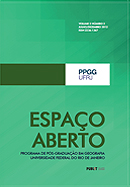“In the Dead of Night”: Modernity and Conservatism in the Nightlife of the City of Rio de Janeiro (1760-1950)
DOI:
https://doi.org/10.36403/espacoaberto.2015.2690Keywords:
Nightlife, Sociability, Urban Lighting, Public Space, Rio de Janeiro.Abstract
The purpose of this article is to understand, from a geographic look at the past, the place of night in the social life of Rio de Janeiro in the period in which the city was the capital of Brazil. What we call here nightlife relates thus to the practices occurring in public spaces at night. There are few reports about this nightlife, much because of the conservative character of the carioca elite, which seems to have preferred to conduct vening activities in private places. The available data tell us, however, that the process of public space appropriation during nightime was developed from popular practices in some areas of the city, especially near its center, until the mid-twentieth century. The progress of the night as a time of publicity seems to correlate well with more general changes in the organization of the city and its modernization process.


